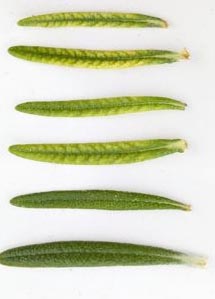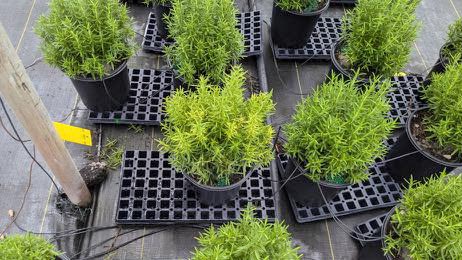
(Photo: Brian Whipker
Interveinal chlorosis of the new leaves usually means iron problems. A few scattered rosemary plants had symptoms and they had one thing in common. They were under a dripping irrigation nozzle that kept the substrate overly saturated and may have limited the plant from obtaining iron. In addition, lime had been added to the top of the pot and the dripping water helped make it more available to increase the substrate pH.
On a recent extension trip, we were able to scout an impressive crop of rosemary plants being grown in the shape of Christmas trees.
Three plants out of 20,000 isn’t much. Those 3 plants all had interveinal chlorosis of the new leaves. These are typical iron (Fe) deficiency symptoms.
All three plants also had in common that they were the only ones exhibiting symptoms and they were being grown under a dripping irrigation nozzle. All of the surrounding plants were normal green. This was a case of excessive moisture limiting Fe uptake by the plant. In addition, a dose of limestone had been added to the top of the pot. It appears the extra moisture helped make more of limestone had been added to the top of the pot. It appears the extra moisture helped make more of the limestone available to modify the substrate pH. A pourthru test found the pH to be elevated at 6.6. Similar symptoms can also develop in the case of another physiological disorder caused by cold growing conditions, abiotic factors such as root rot, and the less common Fe deficiency due to inadequate levels being provided.


(right). (Photo: Brian Whipker)
Confirmation of Diagnosis
Obtaining a substrate pH of 6.6 suggests that the elevated pH is contributing to the development of Fe chlorosis. In addition, confirming an iron deficiency diagnosis with leaf tissue analysis can be challenging. Low levels may not always be confirmed.
Corrective Procedures
The easy fix is to avoid having super-saturated substrates. We have observed with other plants that normal green new growth can return if the plant is allowed to dry down between irrigations. The yellow tissue may be slow to turn green and in some cases may not regain colour. An iron chelate application may also be beneficial to help make additional iron available to the plant.
Conclusion
Iron deficiency of rosemary and other plant species can occur if the substrate is too wet. When symptoms appear, be sure to check the roots, substrate pH, and the moisture level of the substrate to help diagnose the situation and then plot correction steps.
For us, we ran a leaf tissue analysis and found Fe to be low at 48.9 ppm according to the NCDA&CS lab standards
Read more at e-gro.org
